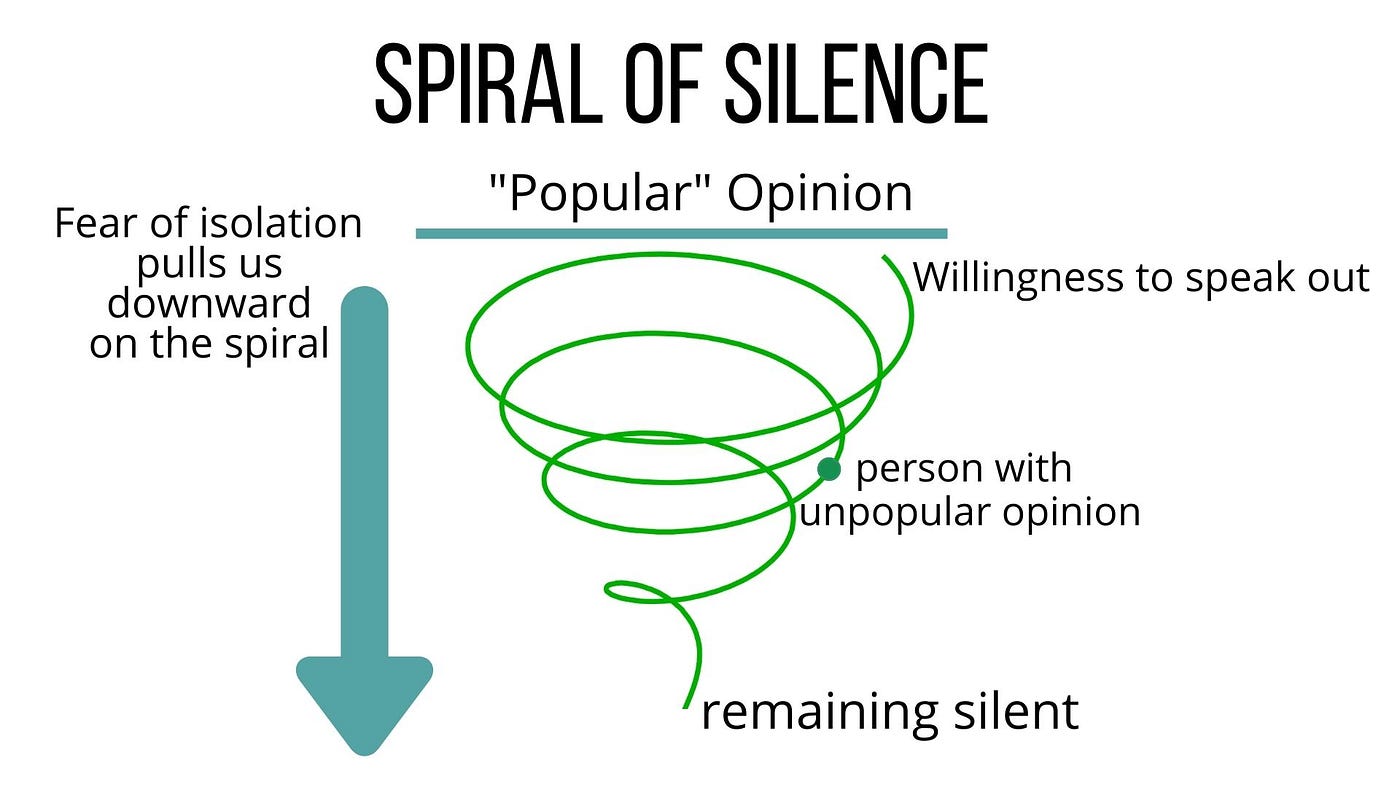
The Spiral of Silence explains how a person (or group) is less likely to voice an opinion when the majority thinks something else. People tend to keep silent when they feel left out, they feel as though their opinions aren't recognized, the fear of laughter or judgement, and when people can't take criticism. All everyone wants is to feel accepted into society and different groups. When someone from the majority speaks out their ideas confidently, the minority wants to back away and becomes silent/distant. But, the closer the ideas are to the majority, the closer the minority speaks out their opinions.
The idea of spiral of silence was developed by German communication researcher Elizabeth Noelle-Neumann in the 1960's-1970's. Her experiences during the WWII and post-war era led to her to observe the power of the public opinion and the danger of not listening to all voices.
Some negative effects are that social groups exclude members because of their views and opinions which then gain fear of isolation. Some positive effects could be the discouraging of extreme or unpopular opinions and viewpoints that might otherwise disrupt harmony within a group. It could encourage individuals to think about all the viewpoints and think critically. They could reconsider their stance if it is way off what the majority thinks.

The spiral of silence has an effect as a whole on society. Lack of discussion can cause more divides and eventually lead to social polarization (division into two sharply contrasting groups or sets of opinions). Governments, institutions, and companies may base their opinions on the majority views, potentially looking over important perspectives that weren't openly expressed. The needs of the minority need to be addressed.
Some examples of spiral of silence could include climate change, The Civil Rights movement, The Great Depression, young/old, and female/male.
Climate change in some communities people who believe in the science of climate change remain silent in the public due to the overall climate skepticism within certain social or political groups.
The Great Depression had many individuals face severe economic hardships and were reluctant to voice dissatisfaction with the government policies or banks. They feared losing any type of social stranding or jobs.
The Civil Rights movement had many individuals support racial equality that were hesitant to speak out against segregation laws and practices due to fear of violence or social exclusion.
Young people feel the pressure to conform to society and fit in. If their opinions are different, then they feel left out. This could lead to bullying, isolation, and social rejection. The younger generation on social media might get certain videos, photos, or viewpoints on their feed causing them to think a certain way. Older people get disconnected from the world and younger generation because society is constantly changing and growing. This viewpoints are outdated, and the older generation stays silent.
Females in the past and even now have felt the pressure to conform to society and become a specific person that society makes out females to be. This could cause the spiral of silence where women hold back their opinions. If women are in a man mainly dominated workplace they could keep their views away from the workplace. Women don’t want certain labels on themselves. Males might feel the pressure to always feel confident and assertive which can prevent them from being vulnerable and expressive of their opinions because of how society labels males. Males might go into a spiral of silence because they don’t want the repetition to be on the line.
Other common issues today that use the spiral of silence include abortion, vaccines, social movements, and political views.
Understanding this dynamic is crucial for caring for the environments where many different viewpoints can coexist without fear of isolation, conflict, and judgement.

No comments:
Post a Comment